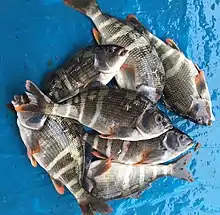| Microcotyle danielcarrioni | |
|---|---|
| Scientific classification | |
| Domain: | Eukaryota |
| Kingdom: | Animalia |
| Phylum: | Platyhelminthes |
| Class: | Monogenea |
| Order: | Mazocraeidea |
| Family: | Microcotylidae |
| Genus: | Microcotyle |
| Species: | M. danielcarrioni |
| Binomial name | |
| Microcotyle danielcarrioni | |
| Synonyms | |
| |
Microcotyle danielcarrioni is a species of monogenean, parasitic on the gills of a marine fish. It belongs to the family Microcotylidae.[1]
Systematics
Microcotyle danielcarrioni was first described and illustrated based on specimens from the gills of the Peruvian morwong Cheilodactylus variegatus (Cheilodactylidae) off Peru,[1] without referring to holotype number.[3] In the original description, this species was placed in the genus Paramicrocotyle,[1] a genus erected for P. atriobursata and P. tampicensis [4] and distinguished from Microcotyle by the following features: structure of the haptor, structure and shape of the genital atrium and the presence of two vitellovaginal pouches. Sixteen species previously belonging to the genus Microcotyle were placed in this newly erected genus.[4][2] Later, Mamaev (1986) synonymised Paramicrocotyle with Microcotyle,[5] and Paramicrocotyle was considered taxon inquirendum.[6] Mamaev (1986) did not change the generic status of P. danielcarrioni, probably omitted.[2] Oliva & Munoz (1985) suggested that Microcotyle danielcarrioni was a synonym of Microcotyle nemadactylus, but retained it in the genus Paramicrocotyle.[7] Based on morphological similarities between the genus: Microcotyle and Paramicrocotyle, Bouguerche et al., followed Mamaev (1986) and considered Paramicrocotyle a junior synonym of Microcotyleas their molecular analyses included a member of Paramicrocotyle which was placed amongst other species of Microcotyle without having a distinct branch. Paramicrocotyle danielcarrioni was thus transferred to the genus Microcotyle.[2]
Description
Microcotyle danielcarrioni has the general morphology of all species of Microcotyle, with a symmetrical body, comprising an anterior part which contains most organs and a posterior part called the haptor. The haptor is symmetrical, and bears clamps, arranged as two rows, one on each side. The clamps of the haptor attach the animal to the gill of the fish. There are also two buccal suckers at the anterior extremity. The digestive organs include an anterior, terminal mouth, a pharynx, an oesophagus and a posterior intestine with two lateral branches provided with numerous secondary branches. Each adult contains male and female reproductive organs. The reproductive organs include an anterior genital atrium, armed with numerous very spines, a medio-dorsal vagina, a single ovary and a number of testes which are posterior to the ovary.[1]
Hosts and localities

The host-type is the bandfish the Peruvian morwong Cheilodactylus variegatus (Cheilodactylidae).[1] The type locality is off Peru.[1] Microcotyle danielcarrioni was reported again from Cheilodactylus variegatus, off the type locality,[8][9][10] and off Chile.[7][11][10]
References
- 1 2 3 4 5 6 7 Martinez, R., & Barrantes, I. (1977). Helmintos parasitos de Cheilodactylus variegatus Valenciennes, 1833, ‘‘pintadilla’’. I. Paramicrocotyle danielcarrioni n. sp. (Monogenea: Microcotylidae). Biota (Lima), 11, 139–146
- 1 2 3 4 Bouguerche, Chahinez; Gey, Delphine; Justine, Jean-Lou; Tazerouti, Fadila (2019). "Microcotyle visa n. sp. (Monogenea: Microcotylidae), a gill parasite of Pagrus caeruleostictus (Valenciennes) (Teleostei: Sparidae) off the Algerian coast, Western Mediterranean" (PDF). Systematic Parasitology. 96 (2): 131–147. doi:10.1007/s11230-019-09842-2. ISSN 0165-5752. PMID 30701382. S2CID 59526278. (subscription required)
- ↑ Morales, E., Sarmiento, L., Sánchez, L., Floríndez, D., & Lamas, G. (2005). Material tipo de helmintos en el Museo de Historia Natural, Universidad Nacional Mayor de San Marcos,(MUSM), Lima, Perú. Revista Peruana de Biología, 12(3), 463-472. PDF

- 1 2 Caballero y Caballero, E., & Bravo-Hollis, M. (1972). Monogenea (van Beneden, 1858) Carus, 1863 de peces marinos del litoral Mexicano del Golfo de Mexico y del Mar Caribe.V. Revista de Biología Tropical, 20, 151-165. PDF

- ↑ Mamaev, Y. L. (1986). The taxonomical composition of the family Microcotylidae Taschenberg, 1879 (Monogenea). Folia Parasitologica, 33, 199-206. PDF

- ↑ Mendoza-Franco, Edgar F.; Rosado Tun, Mariela del Carmen; Duarte Anchevida, Allan de Jesús; del Rio Rodríguez, Rodolfo E. (2018). "Morphological and molecular (28S rRNA) data of monogeneans (Platyhelminthes) infecting the gill lamellae of marine fishes in the Campeche Bank, southwest Gulf of Mexico". ZooKeys (783): 125–161. doi:10.3897/zookeys.783.26218. ISSN 1313-2970. PMC 6160863. PMID 30275730.
- 1 2 Oliva, M. E., & Munoz, M. A. (1985). Microcotyloidea (Platyhelminthes: Monogenea) en peces marinos de la zona de Antofagasta. Estud. Oceanol, 4, 1-8.
- ↑ Tantaleán MV & AF Huiza 1994. Sinopsis de los parásitos de peces marinos de la costa Peruana. Biotempo, 1: 53-101.
- ↑ Iannacone J 2003. The parasitofauna of Scomber japonicus Houttuyn 1782 (Pisces: Scombridae) in two zones of the Argentine Sea. Revista Brasileira de Biologia, 20: 257-260
- 1 2 Eiras, J. C., Velloso, A. L., & PEREIRA-JR, J. (2016). Parasitos de peixes marinhos da América do Sul. Rio Grande, Editora da FURG. PDF

- ↑ Wood CL, F Micheli, M Fernández, S Gelcich, JC Castilla & J Carvajal 2013. Marine protected areas facilitate parasite populations among four fished host species of central Chile. Journal of Animal Ecology, 82: 1276-1287.